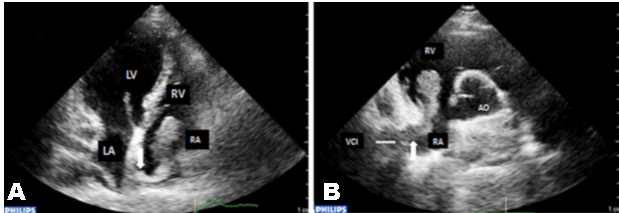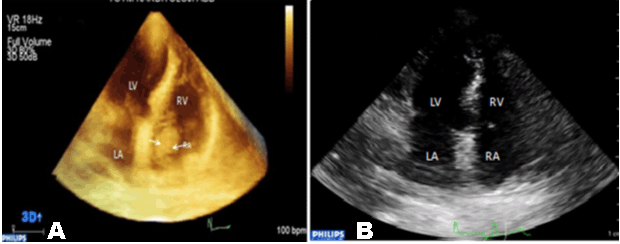| Table of Contents |  |
|
Case Report
|
| Right atrial thrombus derived from inferior vena cava after liver transplantation |
| Erdal Aktürk1, Jülide Yağmur2, Halil Ataş2, Necip Ermis2 Nusret Acikgoz2 Mehmet Cansel2 |
|
1Adiyaman University, Faculty of Medicine, Department of Cardiology, Adiyaman/Turkey.
2Inonu University, Faculty of Medicine, Department of Cardiology, Malatya/Turkey. |
|
doi:10.5348/ijcri-2012-07-152-CR-13
|
|
Address correspondence to: Erdal Aktürk Cardiology Department Adiyaman/Turkey Phone: +0090 422 3410660, ext. 4500, Gsm: 5335480167 Fax: +0090 422 3412708 Email: erdalakturk@hotmail.com |
|
[HTML Abstract]
[PDF Full Text]
|
| How to cite this article: |
| Aktürk E, Yağmur J, Ataş H, Ermis N, Acikgoz N, Cansel M. Right atrial thrombus derived from inferior vena cava after liver transplantation. International Journal of Case Reports and Images 2012;3(7):52–55. |
|
Abstract
|
|
Introduction:
Right-sided cardiac thrombi may develop due to secondary causes. Their incidence is very low and only a few case reports of right atrial (RA) thrombi exit in literature.
Case Report: We report the case of a 56-year-old patient with orthotopic liver transplantation (OLT) about six months back, who was admitted to our clinic with symptoms of worsening chest pain and shortness of breath. Two and three-dimensional transthoracic echocardiography (3DTTE) and transesophageal echocardiogram (TEE) showed a mobile right atrial thrombus 3.9×1.8 cm in size, traversing the right atrial cavity during the whole cardiac cycle. After one week of therapeutic anticoagulation, the thrombus began to shrink and after three weeks echocardiography confirmed no evidence of residual thrombus. Conclusion: In contrast to previously reported cases of massive RA thrombosis developing intraoperatively during OLT, in our case a RA thrombus developed six months after OLT. The right atrial thrombus was derived from inferior vena cava. | |
|
Key Words:
Liver transplantation, Right atrial thrombus, Echocardiography
| |
|
Introduction
|
|
Cardiac thrombi constitute only a fraction of cardiac masses. Left-sided cardiac thrombi are often associated with myocardial infarction, dilated cardiomyopathy or mitral valve disease. On the other hand, right-sided cardiac thrombi may arise due to secondary causes. Their incidence is low and only a few case reports of right atrial (RA) thrombus have been described in literature. [1] [2] [3] We report a case of mobile right atrial thrombus diagnosed by two and three-dimensional transthoracic echocardiography (TTE). This is the first case report in which a combination of radiologic methods were used for the assessment of right atrial thrombus which developed in inferior vena cava (IVC). |
|
Case Report
|
|
A 53-year-old female patient was admitted to our center because of dyspnea and chest pain. She had a previous history of diabetes mellitus (DM) and had orthotopic liver transplantation (OLT) six months back because of hepatitis B virus (HBV) infection. She presented with a three-week history of chest pain and progressive shortness of breath. Cardiac auscultation was unremarkable, body temperature was 37°C, blood pressure was 130/85 mmHg, heart rate was 85 beats per minute. Respiratory examination and electrocardiogram were normal. Laboratory tests pro-NT brain natriuretic peptide and D-dimer were normal. Lung scan excluded pulmonary embolism. The chest X-ray and computed tomography (CT) scan were normal. CT scan showed a 3.5x1.5x2.5 cm mass in the right atrium near IVC orifice. There was no evidence of deep vein thrombosis on duplex scanning and V/Q scan was negative. Echocardiography showed that the mobile right atrial mass was highly suspicious of a thrombus traversing the right atrial cavity during the cardiac cycle. It was accompanied with free-floating parts of the thrombi. It vertically stretched in the RA and during diastole touched the tricuspid valve (Figures 1A, B). 3DTTE was performed to further confirm the nature of mass. It showed a highly mobile homogenous thrombus, irregular in contour, measuring 3.9×1.8 cm, which originated from IVC and protruding into the RA cavity (Figure 2A). Patient was started on low molecular weight heparin and warfarin. Warfarin dose was adjusted to INR ratio 2–3. The patient had an uneventful hospital course and after one weeks, follow-up the thrombus began to shrink. After three weeks, echocardiography confirmed no evidence of residual thrombus (Figure 2B). |
|
|
|
|
|
Discussion
|
|
There are few previous published reports of spontaneous right atrial thrombus after interventional procedures such as central venous catheter and transvenous pacing leads as well as in patients with multisystem inflammatory diseases such as Bechet's syndrome, systemic lupus erythomatosis, crohn's disease, [4] [5] constructive pericarditis, [6] 5-fluorouracil cardiotoxicity, [7] dilated cardiomyopathy [8] and diffuse liver amoebiasis. [9] Hypercoagulable state caused by diseases or peripheral venous clots in bedridden patient may cause a thrombus which embolizes to the right heart. This type of thrombus presents leads to a higher mortality with a risk of potential fragmentation and causing massive pulmonary embolization. [10] [11] Despite previously reported massive RA thrombosis intraoperatively on OLT, [12] a RA thrombus developing months after OLT has not been reported. The cardiac evaluation by TTE was normal before liver transplantation and for this reason the diagnosis of a cardiac tumor was excluded. We considered the diagnosis of a thrombus based on the patient's clinical and echocardiogram findings. This case did not have a predisposing condition for a thrombus to form in the right atrium. RA thrombus may be related to a tendency of thrombosis due to technical problems associated with the vascular anastomoses or DM causing chronic platelet stimulation. TTE can help to estimate cardiac structure, function and assess the hemodynamic effects, whereas 3DTTE adds valuable benefits as it can provide complete information about intracardiac masses including size, shape, consistency, mobility and location in relation to cardiac anatomical structures. It allows to differentiate the thrombus from other masses (e.g. cardiac tumors, vegetations) by revealing lobula and stalk of thrombus, hyperechogenicity or hypoerechogenicity and an echo-lucent area (the echo-lucent area in the centre of the mass in our case was indicative of clot lysis). |
|
Conclusion
|
|
In summary, this case suggests that in patients presenting with shortness of breath or other non-specific complaints after OTL, assessment by echocardiography is very important. During the echocardiography examination of these patients right atrium and inferior vena cana must be carefully evaluated. |
|
References
|
|
|
[HTML Abstract]
[PDF Full Text]
|
|
Author Contributions:
Erdal Aktürk - Substancial contribution to the conception and design, Acquisition of data, Analysis and interpretation of data, Drafting the article, Revising it critically for important intellectual content, Final approval of data Jülide Yağmur - Substancial contribution to the conception and design, Analysis and interpretation of data, Drafting the article, Revising it critically for important intellectual content, Final approval of data Halil Ataş - Substancial contribution to the conception and design, Revising it critically for important intellectual content, Final approval of version to be published Necip Ermis - Analysis and interpretation of data, Revising it critically for important intellectual content, Final approval of version to be published Nusret Acikgoz - Acquisition of data, Drafting the article, Revising it critically for important intellectual content, Final approval of data Mehmet Cansel - Acquisition of data, Drafting the article, Revising it critically for important intellectual content, Final approval of data |
|
Guarantor of submission:
The corresponding author is the guarantor of submission. |
|
Source of support:
None |
|
Conflict of interest:
Authors declare no conflict of interest. |
|
Copyright:
© Erdal Aktürk et al. 2012; This article is distributed the terms of Creative Commons Attribution License which permits unrestricted use, distribution and reproduction in any means provided the original authors and original publisher are properly credited. (Please see Copyright Policy for more information.) |
|
|



